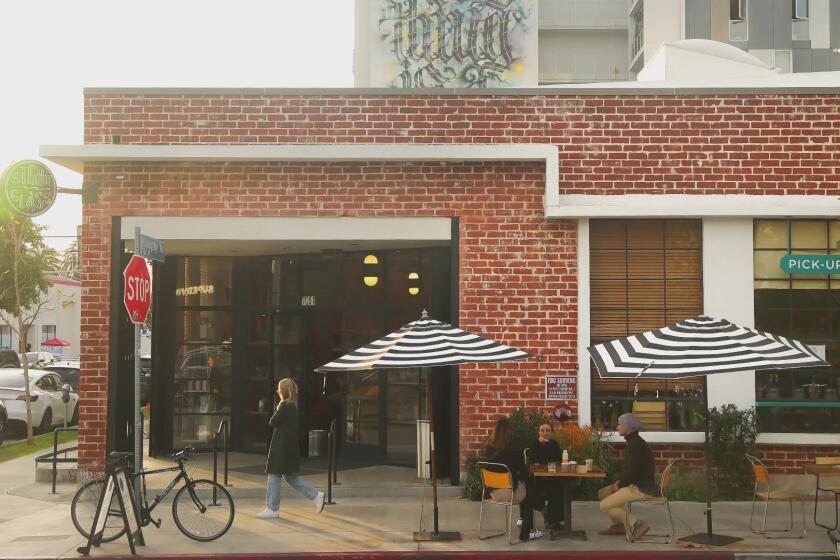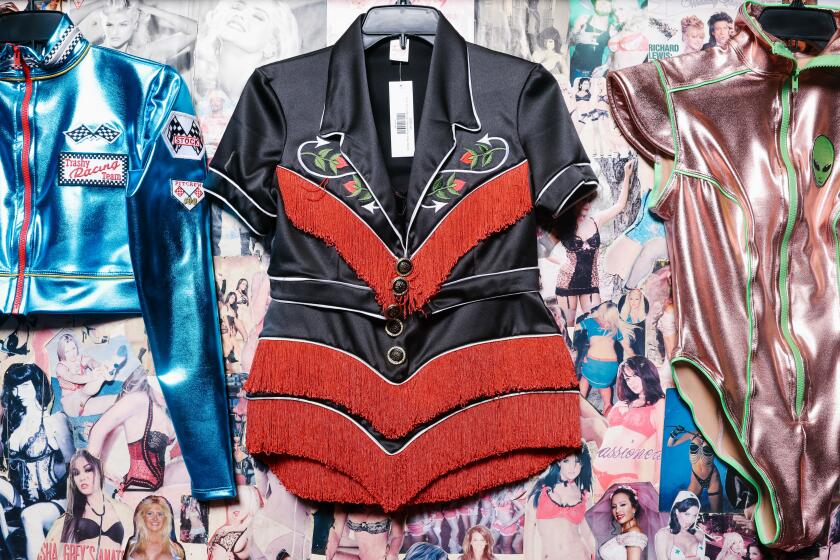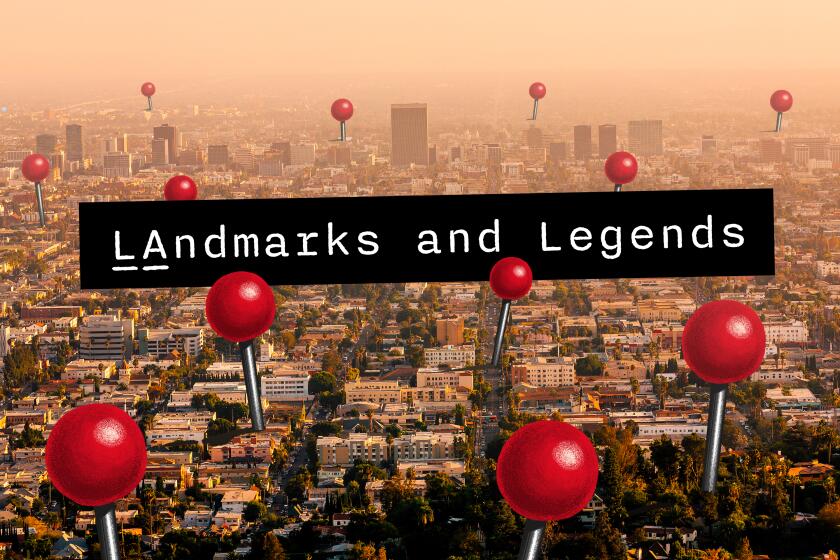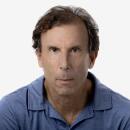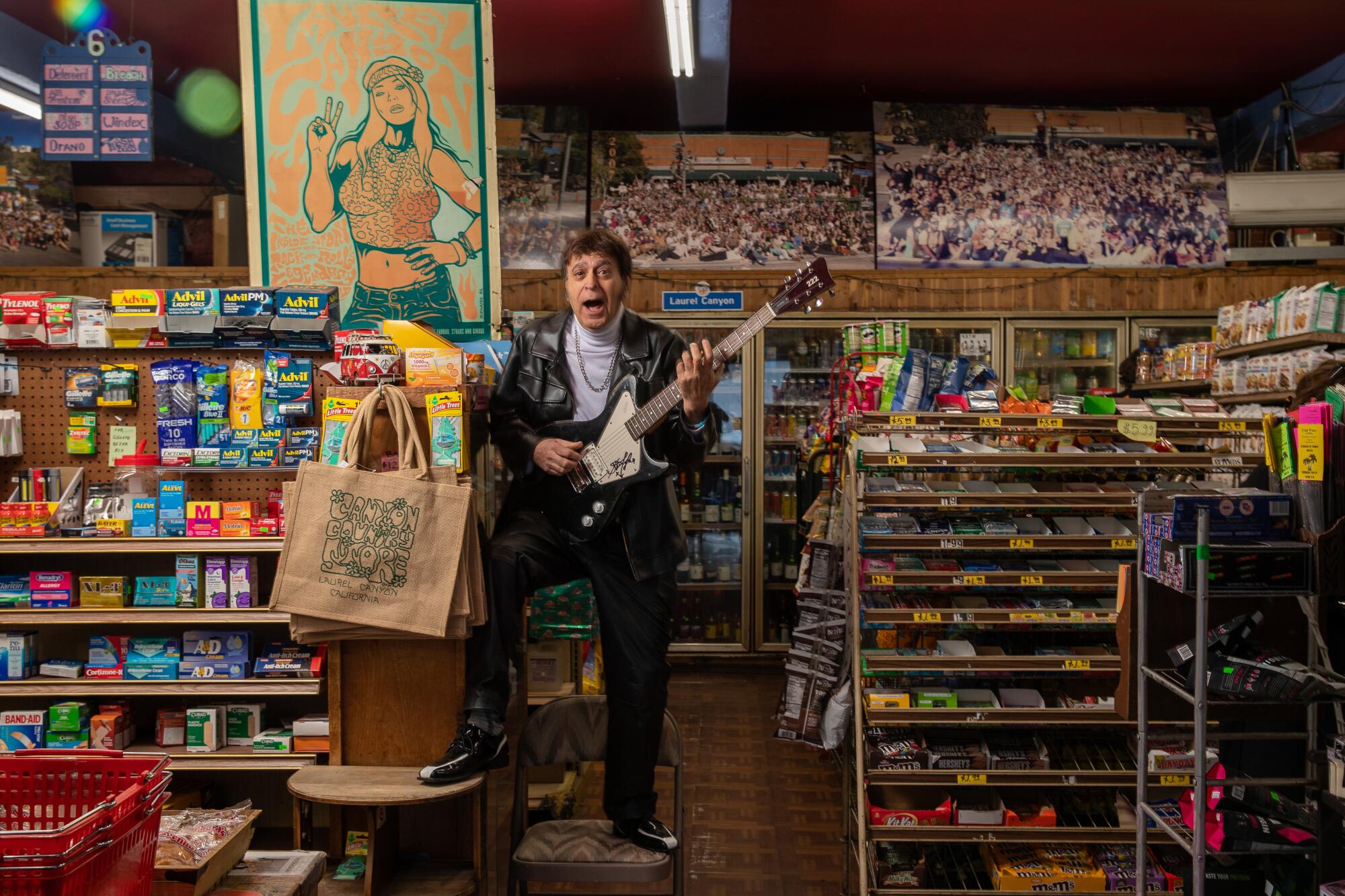
- Share via
As cars loudly race up Laurel Canyon Boulevard on their way from Hollywood to the Valley, the Canyon Country Store sits quietly in the middle of the street. Walking into the quaint, unassuming grocery store is like stepping into a time capsule, one filled with a legendary musical past.
The store is like a shrine to the neighborhood’s famous residents. Photos taken in the shop of Laurel Canyon rock stars who made it big in the 1960s, including David Crosby, Graham Nash and Joni Mitchell, dot the walls and hang above the cash register. A sign with the Doors’ iconic line “Come on baby light my fire” marks firewood bundles for sale.

The preservationist behind this “Laurel Canyon scene” is Tommy Bina, who has owned the store for roughly four decades. Dressed in a retro white turtleneck and black leather pants, he jokes, “I’m trying to bring back the spirit of Laurel Canyon.”
In the 1960s, musicians like those honored in the store flocked to the Hollywood Hills neighborhood, creating what became known as the folksy “Laurel Canyon sound.” Laurel Canyon was Los Angeles’ counterpart to San Francisco’s Haight-Ashbury at the time. “Back then,” Bina, who likes to think of himself as ageless, says, “it was all about the music. And the music was so great, I just don’t want people to forget about the magical era in the canyon.” He admires the antiestablishment lifestyle embraced by the canyon’s rock stars too. He’s decorated the front patio with colorful 1960s flower-power paintings by artist and production designer Spike Stewart and a flag that says “The United State of Laurel Canyon.”
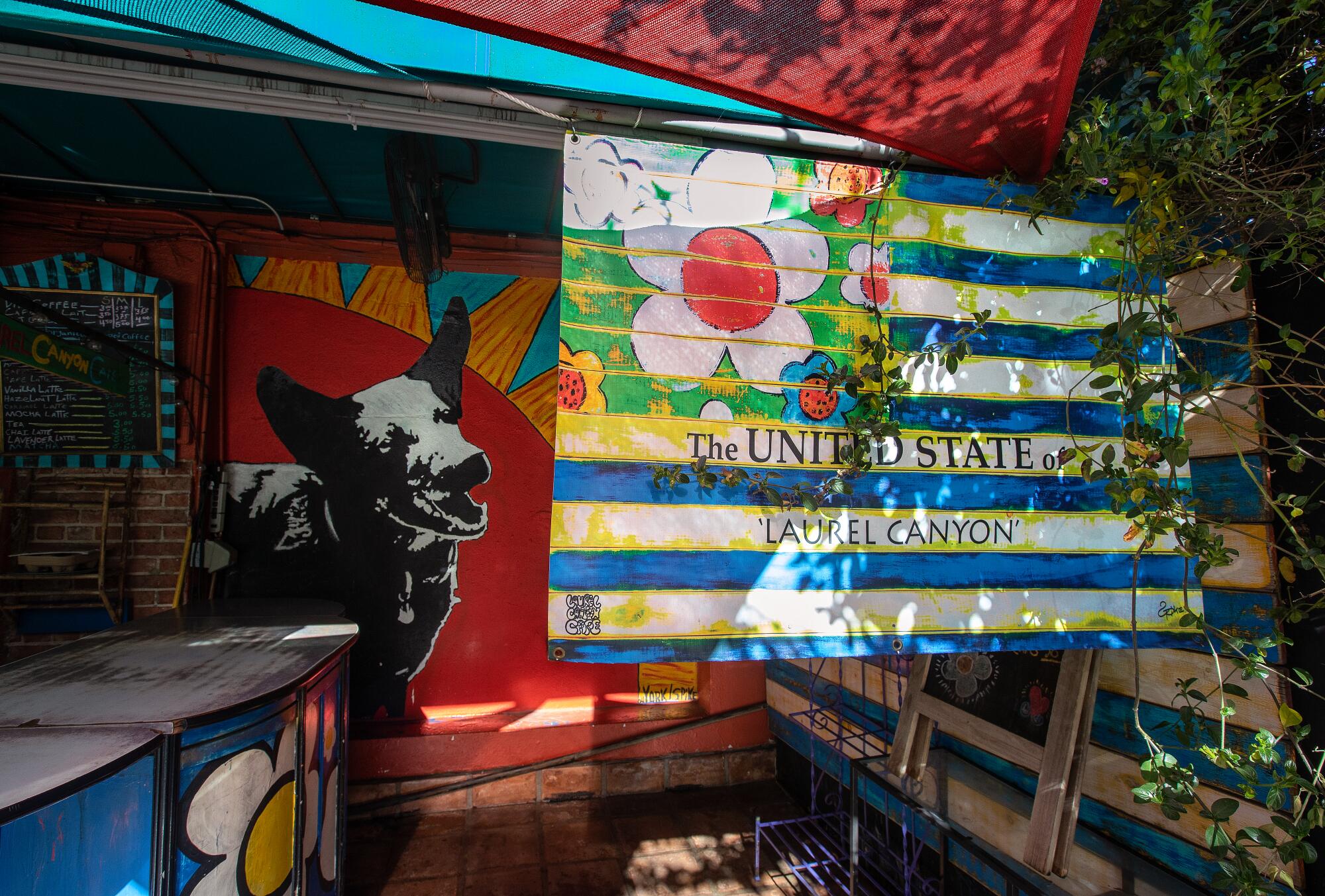
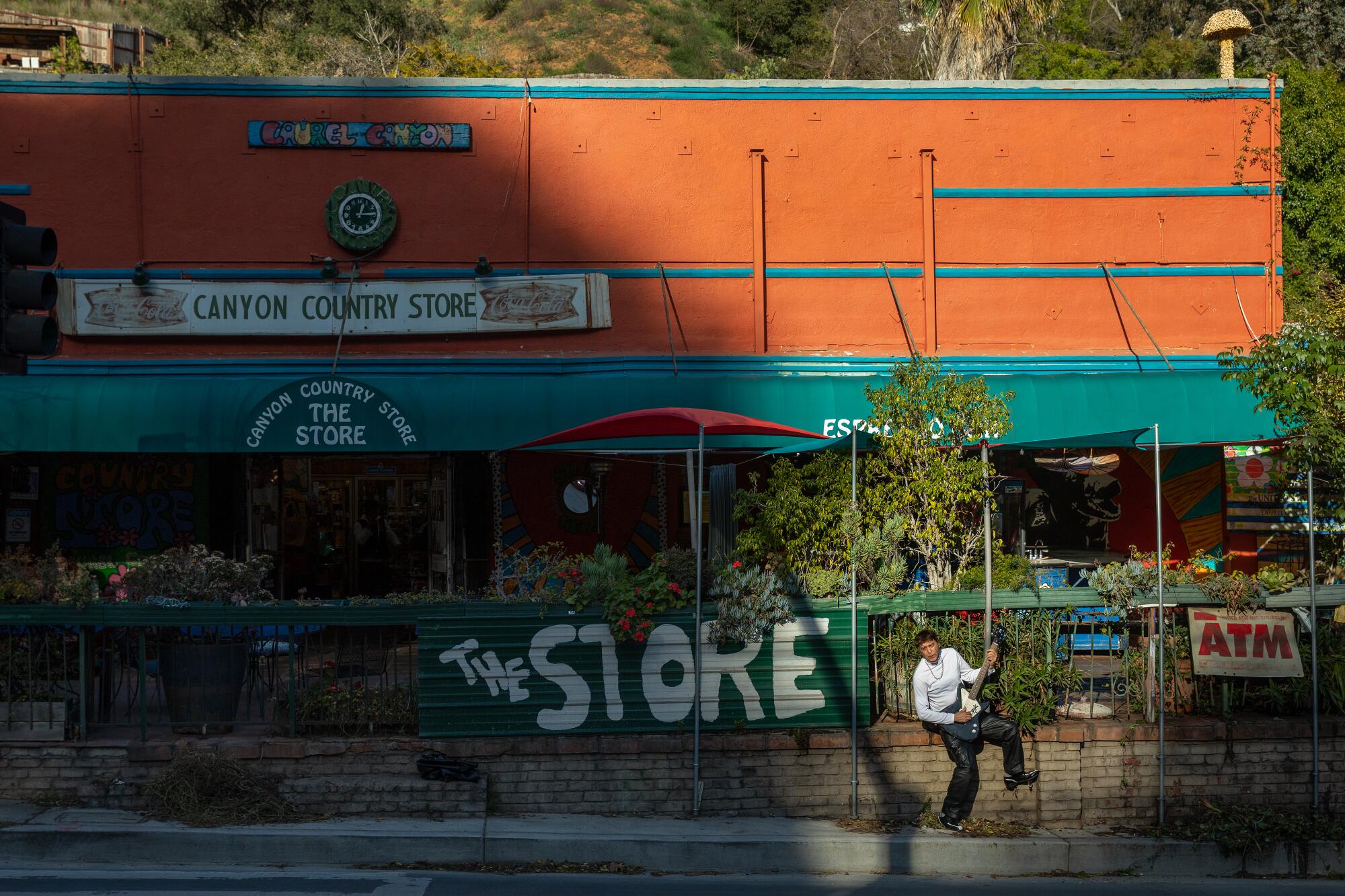
California Dreamin’
Looking for more opportunities in America in the 1970s, Bina moved to Los Angeles from Tehran when he was 15 “all by myself,” he says. His first stop was Alabama to move in with relatives. “When I first arrived I was a total stranger, and I didn’t know anyone, but I really liked the Southern hospitality,” he says. Family in Tehran sent him money as he studied for a GED. He went on to community college in Alabama and business school in New Orleans. “But I dreamed of California,” he says.
When Bina moved to Los Angeles, he supported himself by working at a Hilton hotel. The hospitality business suited his friendly, fun personality. He saved money and, along with a business partner, bought the building on Laurel Canyon Boulevard (he didn’t want to disclose for how much) and opened the store in 1982. “We first considered buying a liquor store, but at the time, those cost four times more than buying a grocery store. The building has been a grocery store since 1903. I wanted to live the American Dream,” he recalls.
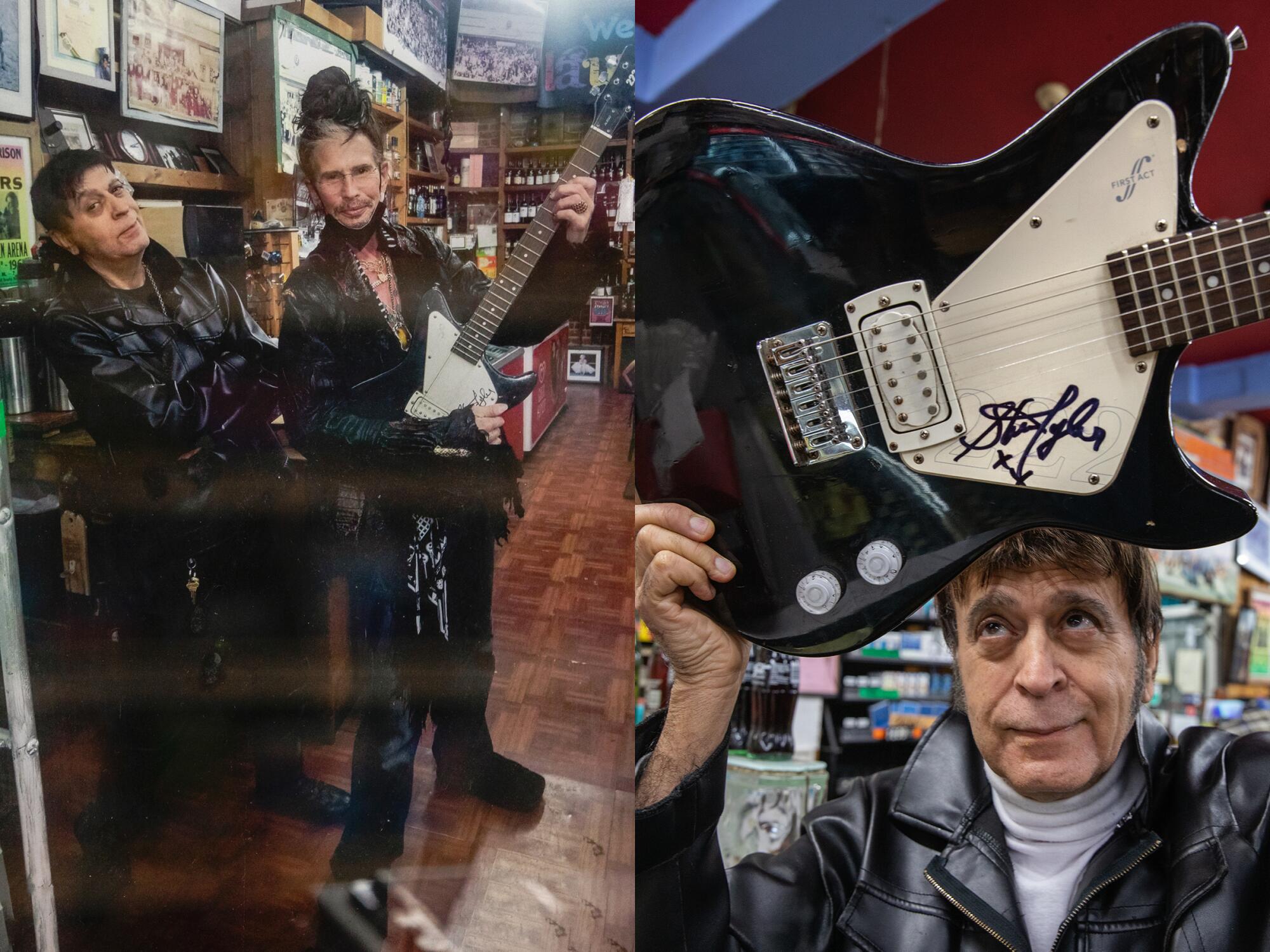
“When I was 14, my biggest idol in Iran was Steven Tyler of Aerosmith,” Bina says excitedly. “And when I just opened the store, like the first week, I saw him walk into the store — and it blew my mind! I told him he was my childhood idol, and he hugged me. We became friends. It was my dream come true.”
Above the cash register is a photo of the Aerosmith singer, with Bina posed next to him like he’s in the band. “It’s definitely my dad’s favorite store in the world,” Mia Tyler says.
Food, art and fashion intersect on a stretch of North Sycamore Avenue in Hollywood. In a short time, it has become one of L.A.’s best new places to explore.
The store has a deli featuring fresh salads and sandwiches. As Bina prepares an egg salad sandwich, a customer says, “These always hit the spot when I have a hangover,” so Bina gives some extra for free. The store carries a large selection of wines, including a Laurel Canyon house wine that people buy for the Canyon Country Store label and $11.99 price tag. The shop also carries homemade cookies and British candy. “I started carrying British candy in 1987 when this English guy kept coming in and asking if I could order it for him. He always dressed in flashy suits, so I thought he was a car salesman. Then I realized it was David Bowie. I still sell a lot of British candy,” Bina says.

Bina delights in giving customers his personal “rock ’n’ roll tour” of the store. Stepping down into the basement, which is now a storage room, Bina says in the mid-’60s, “Mama Cass of the Mamas and [the] Papas lived down here. ... Those stairs up there led out to the parking lot so she didn’t have to walk through the store every time she went out.” A poster of Cass adorns the wall, captioned “Mama Cass lived here.” She’d later buy actress Natalie Wood’s house in Laurel Canyon.
Bina walks back up a flight of wooden stairs and points out a poster of singer Jackie DeShannon. She posed on the very same stairs looking groovy with long bangs and bell bottoms to promote her 1968 album “Laurel Canyon.”
Outside, Bina points to a “Love Street” sign next to the store. It’s where Jim Morrison resided with girlfriend Pamela Courson. “They say that Morrison and his girlfriend would sit on their balcony and watch the hippies go in and out of the store,” says Bina. In the 1968 Doors song of the same name, Jim Morrison sings, “I see you live on Love Street. There’s the store where the creatures meet.”
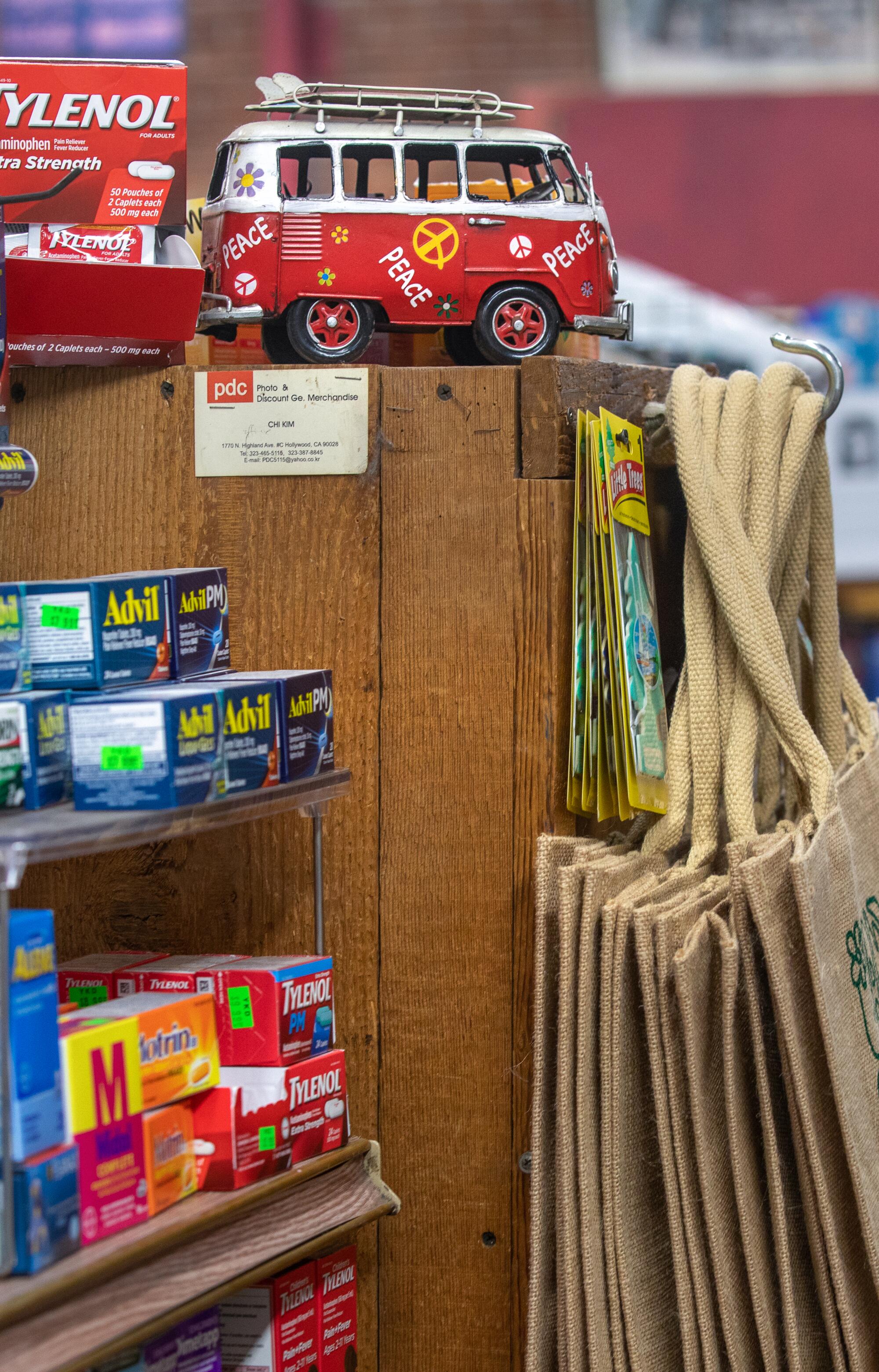
In the summer, Bina hosts an annual Love Street Festival, with bands playing on the patio. “This summer the festival is going to be bigger than ever,” he promises. “In past years, we had Robby Krieger come down and jam, as well as Michelle Phillips of the Mamas and [the] Papas. It’s going to be the Summer of Love again in Laurel Canyon.”
Many songs were written in the lush and beautiful canyon, with its park-like setting, sparkly hillside views, and sweet smells of honeysuckle. Graham Nash wrote the song “Our House” about his romance with Joni Mitchell, and Mitchell wrote the song “Ladies of the Canyon.” Back in the 1960s, Laurel Canyon had plenty of cheap rentals. Today a house in the canyon will cost you at least $2 million.
In the store’s parking lot, valet drivers park cars for Pace, an Italian restaurant that rents the space below the store. When asked who was the most famous person they’ve seen in the store, one valet yells “Madonna!” Another shouts, “Lady Gaga!” A third says, “George Clooney,” and a fourth says, “Kim Kardashian!” Bina says that Jennifer Aniston worked at the store — for three days. “But on the fourth day, she told me she had an audition,” he says, “and she never came back.”
Trashy Lingerie in Hollywood sparked the “sexy Halloween industry” 50 years ago. A new generation of costume shoppers flocks to the members-only store.
Henry Wilson, who’s worked at the canyon store on and off for five years, says, “Joaquin Phoenix keeps a pack of cigarettes behind the counter.” He adds, “Harry Styles was always kind when he came into the store, and wrote a song ‘Canyon Moon,’ when he lived here.”
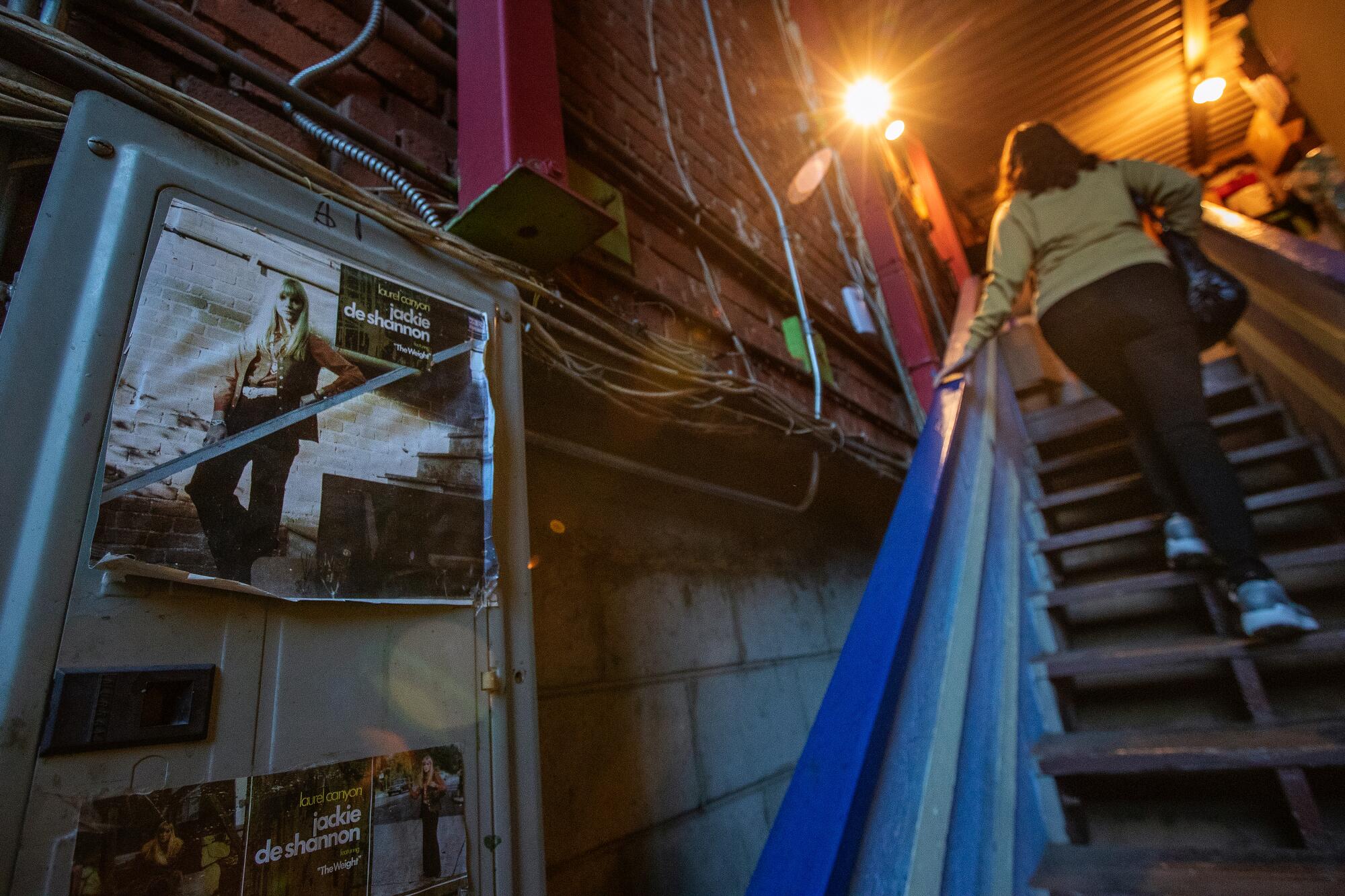
‘Fuhgeddaboudit,’ everything will be OK
Bina, who has dabbled in acting, loves to improv like he’s in “Goodfellas,” to his customers’ amusement. “Hey, how you doin’?,” he says to one. “Good, how ’bout you?” the customer responds, mimicking his mobster accent. Bina then rattles off his classic “Fuhgeddaboudit, I sleep with the fishes.” “I tell everyone who comes into the store ‘Fuhgeddaboudit,’” Bina says. “It’s like telling them not to worry, that everything will be OK.”
Laurel Canyon resident and “Girlfriends’ Guide to Divorce” actress Alanna Ubach says she loves it when he does that, and reports that he “has taken on this Mafia character, and never breaks character.” She jokes that he is “fully committed.” During the pandemic, she says, “When times were tough, Tommy’s Fuhgeddaboudits were comforting.”
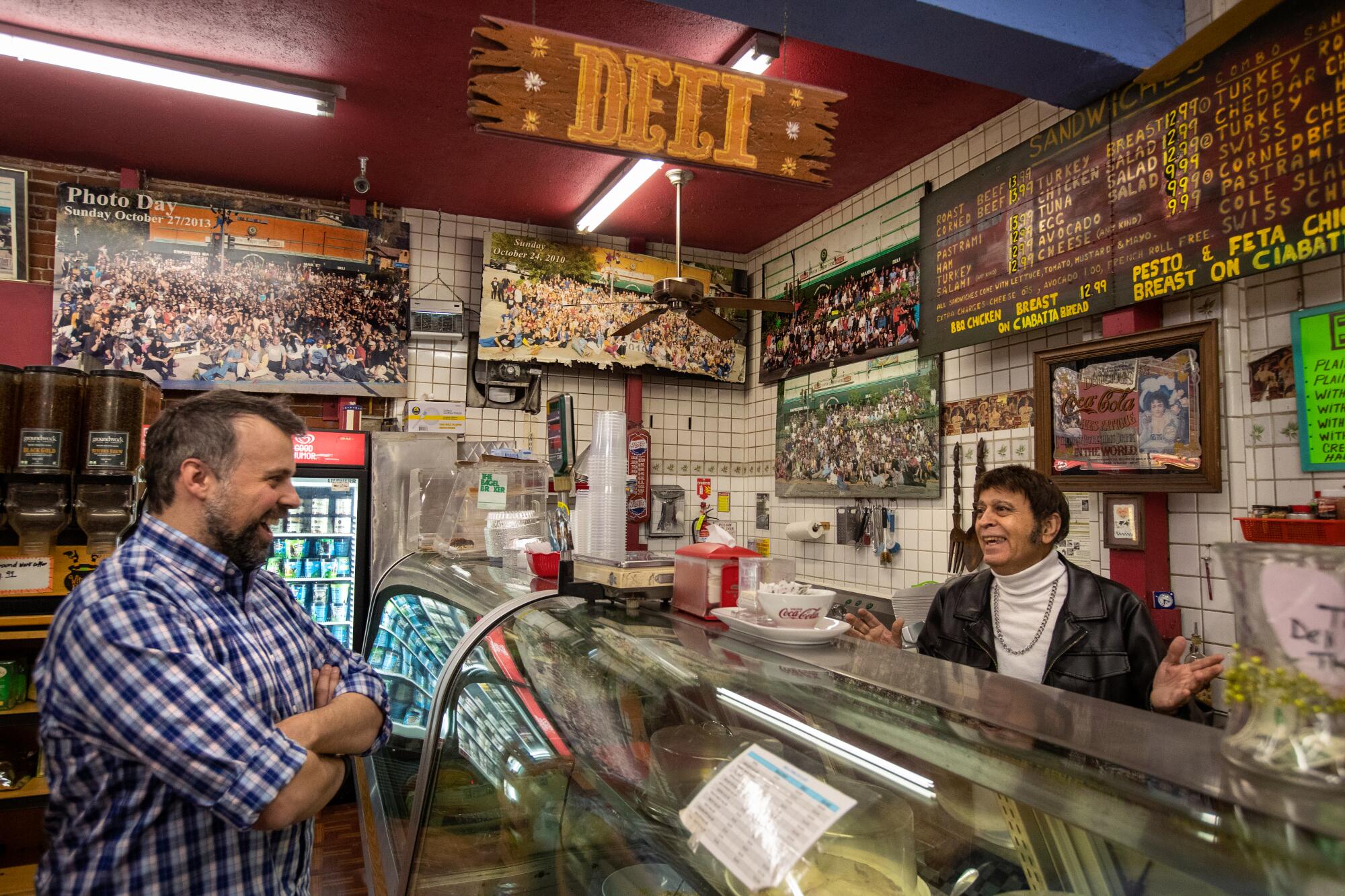
“It’s always a smile with Tommy,” says cardiologist and actor Rico Simonini, a canyon resident who is originally from Brooklyn. “I told Tommy how to pronounce ‘Fuhgeddaboudit’ to sound more New York. So now he pronounces it more like an authentic Brooklyn mobster, but with a Persian accent.”
The store remains a neighborhood institution, with a morning coffee scene on the patio and an annual “picture day” where residents gather for a giant neighborhood group photo. “Picture day started out in 1987 as a way for me to give to my animal charity by selling T-shirts,” says Bina of the Pet Adoption Fund, a no-kill rescue in L.A., “but now it’s a way to continue a sense of community and history in the neighborhood.”
The 1987 neighborhood shot includes a 15-year-old Christina Applegate and hangs above the ice cream freezer. At last year’s picture day, when Applegate was asked where she grew up, she wistfully said, “I grew up here in Laurel Canyon, with all the hippies, in that house right up there, behind the store.”
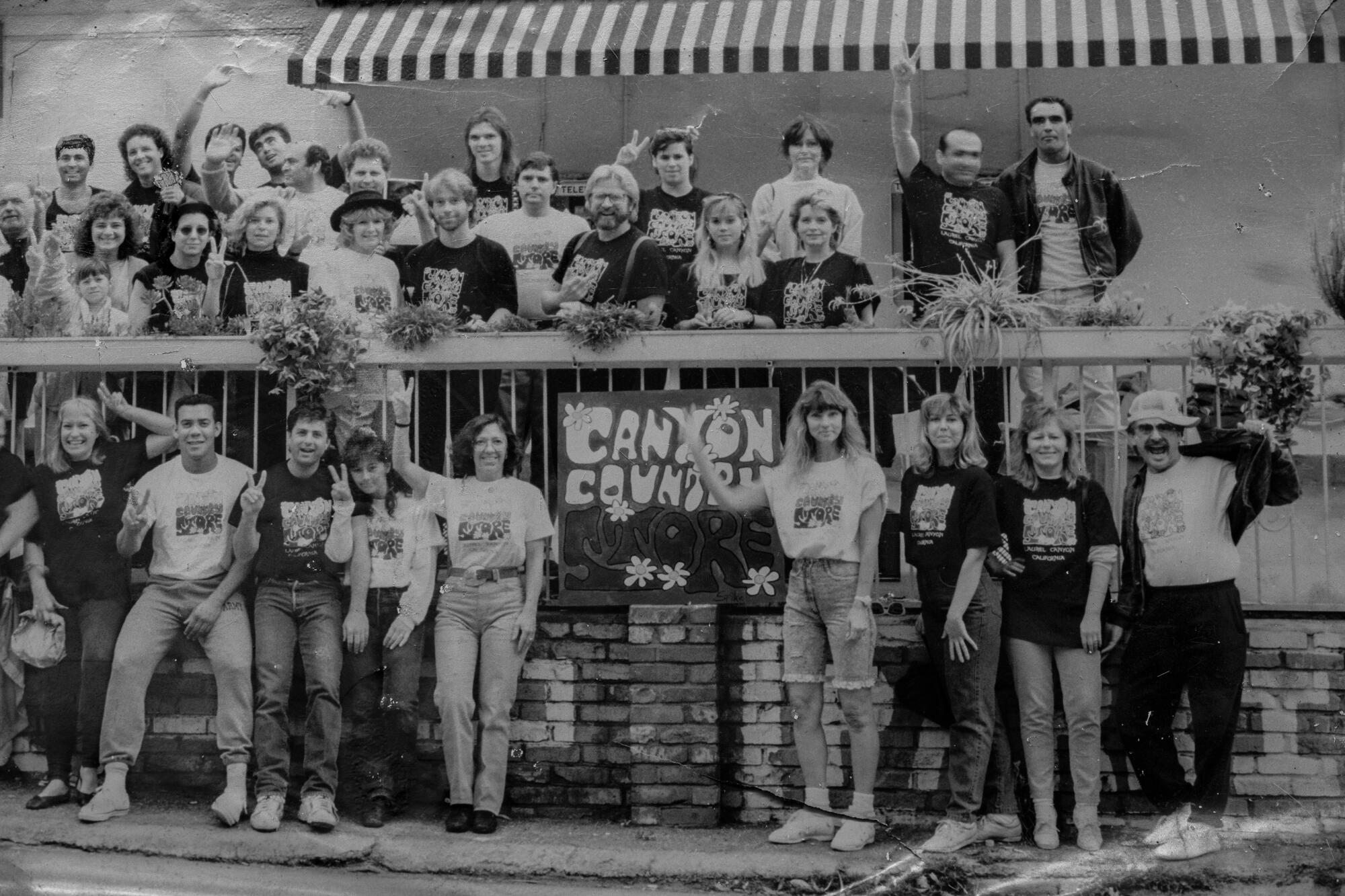
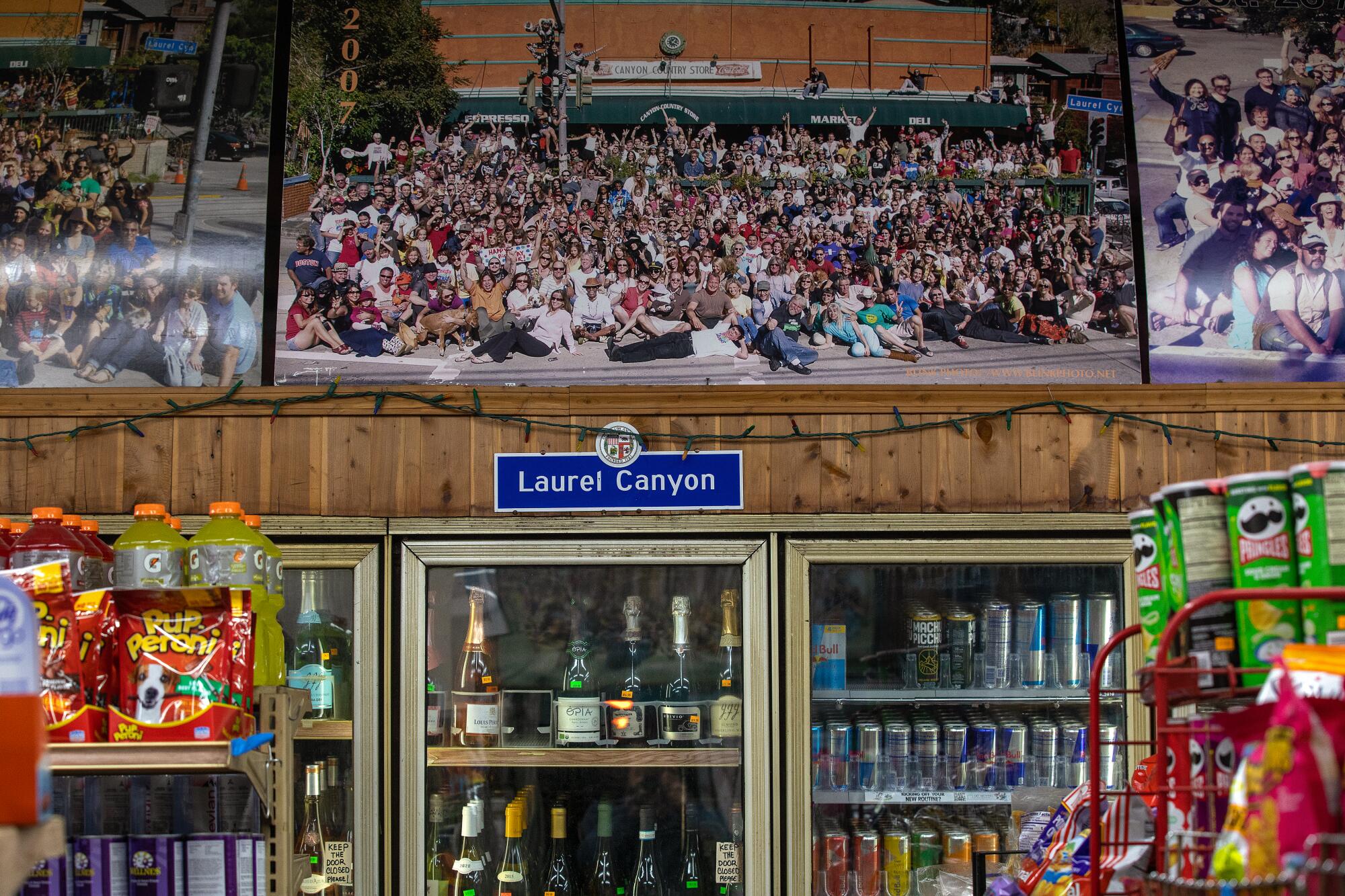
At last year’s picture day in November, about 150 neighbors and their dogs gathered for the shot. “Everybody give the peace sign!” the photographer yelled to the crowd, which included the Flying Morgans, a family of aerialists who live in the canyon and climb the telephone pole every year for the photo.
The peace sign endures, as a last vestige of a bygone rock ’n’ roll hippie past, as seen on the front of the store and side of the building. Flashing the peace sign is standard when someone lets you pass to drive up the tight, windy roads of Laurel Canyon.
Who is Griffith Park named for? What about Vasquez Rocks? The Broad? Mt. Baldy? Here are the namesakes of L.A.’s best-known landmarks.
Outside on the store’s patio, a painting of a giant red heart is a reminder of Laurel Canyon’s “Summer of Love” and a selfie magnet. For Bina, the painting means, “I see you in the mirror. You are in my heart. You are here in Laurel Canyon. A place about peace. And love. And rock ’n’ roll.”

More to Read
Sign up for The Wild
We’ll help you find the best places to hike, bike and run, as well as the perfect silent spots for meditation and yoga.
You may occasionally receive promotional content from the Los Angeles Times.
